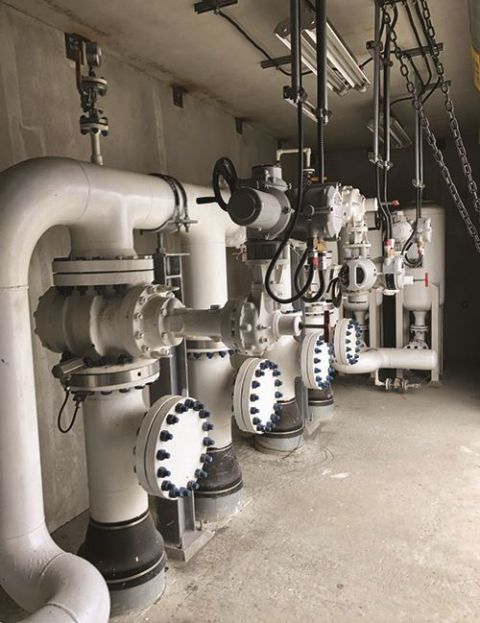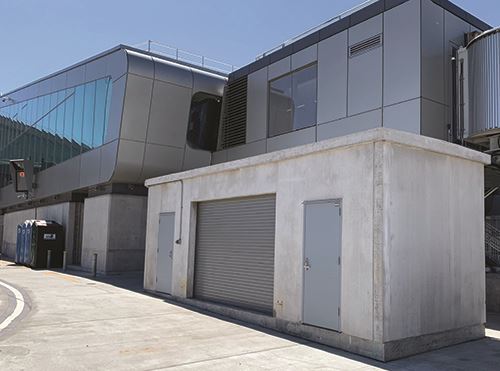New Hydrant System Will Boost Fueling Efficiency and Safety at LaGuardia Terminal B

Prior to a $4 billion facelift recently completed by LaGuardia Gateway Partners, Terminal B at LaGuardia Airport (LGA) was known for taxiway traffic jams and delays. The terminal’s new island concourse layout has helped alleviate many of those issues. Further enhancing those efficiencies is a new hydrant fueling system that will allow aircraft to fuel at each of the terminal’s 35 gates and eliminate the need for tank truck refueling and its associated traffic.
The hydrant systems around the island concourses—designed by Argus Consulting and constructed by Meccon Industries—will also allow operators to efficiently fuel aircraft and sectionalize the concourse systems during an Emergency Fuel Shut Off (EFSO) event or maintenance, limiting the number of gates affected.
Crews are expected to finish installation of the Terminal B ramp hydrant system by the end of 2022, and a separate project to connect the Terminal B and Terminal C ramp hydrant systems with the airport’s Fuel Storage Facility to form an airport wide hydrant system is scheduled to begin construction in the first quarter of 2023.
|
Project: Terminal B Hydrant Fueling System Location: LaGuardia Airport Airport Owner: Port Authority of New York & New Jersey Terminal Operator: LaGuardia Gateway Partners Project Cost: $18 million Timeline: 2016-2022 Design Joint Venture: WSP (lead & engineer of record); HOK (architect of record) Design Build Joint Venture/Construction Manager: Skanska-Walsh Engineering of Record for the Fuel System Design: Argus Consulting Fuel Farm Operator: Allied Aviation Fuel System Contractor: Meccon Industries Inc. |
Until that connection is in place, fuel tank trucks are still being used to transport fuel from the Fuel Storage Facility to each of Terminal B’s gates. The route takes the fuel tank trucks from the Fuel Storage Facility via landside roads, through an Aeronautical Operations Area (AOA) security checkpoint and onto the AOA vehicle service road that leads to the Terminal B gates. After fueling aircraft, fuel tank trucks make the return trip back to the Fuel Storage Facility to reload and repeat the process. When the airport wide hydrant fuel system is completed, that cumbersome trek goes away.
“The elimination of the fuel tank trucks will reduce the vehicle traffic, increase the efficiency and reduce the amount of time that’s required for fueling planes,” says Will Cattouse, Project Manager at Argus Consulting.
Construction of the Terminal B ramp hydrant system by LaGuardia Gateway Partners is one of several early action projects, including Delta’s construction of Terminal C’s ramp hydrant system, preparing for construction of the $165 million airport-wide hydrant system by airline consortium LGA Fuel LLC to improve fueling operations at LGA.
Aboveground Advantages
Removing the 10,000-gallon tank truck refuelers from LGA’s public and airside service roads will eliminate traffic congestion due to the relatively slow-moving refuelers. Additionally, since refuelers will no longer maneuver in close proximity to aircraft on the terminal ramp, safety will be significantly increased. The elimination of tank truck refuelers from the terminal ramps will also make more space available for the remaining ground service equipment to operate.
Typically, EFSO isolation valves are installed in underground vaults. However, that wasn’t an option at Terminal B because of nearby Flushing Bay. “The groundwater table at LaGuardia is high, so no matter how well you build an underground vault to make it waterproof, it’s hard to prevent groundwater and stormwater infiltration into underground vaults—and water and electricity don’t mix,” explains Paul Johnke, Business Unit Director for Argus Consulting.
Additionally, underground vaults are difficult to maintain and operate because they are categorized as confined spaces that require crews to follow stringent OSHA access procedures. To remedy these issues, Argus applied a design solution, aboveground isolation valve stations, that it has used in similar circumstances at other airports.
When Argus engineers evaluated the situation at LGA, they determined this was the way to go. The new Terminal B system employs two precast concrete-reinforced structures that house aboveground isolation valve stations and surge suppression stations. The structures, each the size of a shipping container, are located near the point where the terminal ramp hydrant systems connect to the airport wide hydrant system.
Unlike many airports with more space around their terminals, LGA is extremely congested. The pre-cast enclosures of the aboveground isolation valve stations address this situation by providing four-hour fire separation from the terminal. The associated fire rating for each enclosure is maintained by using four-hour-rated fire shutter overhead doors and four-hour fire-rated “man doors.” In the unlikely event of a fire, the fire would be contained within the structure. The interiors of these spaces are consequently not considered confined spaces, which eliminates the need for confined space entry procedures. For added safety, all the electrical components are explosion proof class 1, Div1/Zone 1 rated.
Beyond the safety benefits, bringing the piping and isolation valves into an aboveground situation makes it much easier to maintain, helping to ensure that the system will work properly when it’s needed. “You’re able to routinely get eyes on certain components of the system to make sure there are no issues with it,” says Cattouse.
Johnke agrees that the aboveground isolation valve stations at Terminal B will be a game-changer for operations and maintenance. “If you provide a good environment for the maintainers and operators, they will do a better job of maintaining and operating the system,” he reasons.
Safer Fueling Operations
Integrating and improving safety was a high priority throughout the project. To that end, in addition to aboveground isolation valve stations, the hydrant system includes an EFSO system with EFSO stations at each gate, six isolation valve vaults and surge suppression stations designed to maximize system flow rates while mitigating transient pressures.
 Cattouse explains that hitting the EFSO button at a gate automatically sends a message to the isolation valve station to close the motor-operated isolation valves, automatically stopping the flow of fuel to that portion of the ramp.
Cattouse explains that hitting the EFSO button at a gate automatically sends a message to the isolation valve station to close the motor-operated isolation valves, automatically stopping the flow of fuel to that portion of the ramp.
Once the Terminal B ramp hydrant system is integrated into the airport-wide hydrant system, its EFSO system will also communicate back to the Fuel Storage Facility, which will give it the capability to shut down the pumps at the Fuel Storage Facility if needed. Meanwhile, any surges that occur in the system will be absorbed by surge suppressors at Terminal B.
“The systems are designed with safe operations in mind,” summarizes Jeremy Curran, vice president of fueling contractor Meccon Industries. “The EFSO system allows operators to shut down the system immediately based on the controls, and close valves to isolate the affected portion of the system. After review, additional valves can be closed if needed to isolate a larger part of the system to allow the rest of the unaffected areas to fuel aircraft.”
Coordinating With Other Construction
Installing the hydrant fueling system was part of the six-phase plan to construct the new Terminal B. During the associated six years, Meccon worked hand-in-hand with the Skanska-Walsh joint venture to coordinate construction, installation, quality control, pressure testing and commissioning of the new hydrant system.
Curran says continuity was a must to keep the project organized and on task—especially when tapping in and out of the workflow. As each phase neared completion, the team needed to look forward to what came next.
“If we left the project at the end of a phase, we might not be tying back into that line for six months to a year,” he explains. “Documenting where crews actually left off and making sure the area would be accessible when they came back—and keeping all that organized—was critical. It required a lot of coordination between us and Skanska-Walsh.”

Such coordination was facilitated by weekly management meetings, where drawings and sequences were updated as phasing plans changed. Curran says the whole process was enhanced by stellar communication. “If we had been off-site for six months, the management team would contact us a month or two before we had to get back out there so we could get all of our ducks in a row,” he says. “When it was time to mobilize, we had very detailed coordination. So as soon as we got on site, we could hit the ground running.”
 Johnke says that personnel from Allied Aviation, the company that operates the Fuel Storage Facility, played a key role for Argus’ portion of the project. “They were always very open and helpful with us when we were programming,” he recalls. “Then, when we moved on to design, they really helped us get a full understanding of how they were operating the system, and how we might be able to transition to what it’s going to be in the future.”
Johnke says that personnel from Allied Aviation, the company that operates the Fuel Storage Facility, played a key role for Argus’ portion of the project. “They were always very open and helpful with us when we were programming,” he recalls. “Then, when we moved on to design, they really helped us get a full understanding of how they were operating the system, and how we might be able to transition to what it’s going to be in the future.”
He also credits strong partnerships with the Port Authority and LGA. “As you can imagine, when we’re building a system that is going to stretch across the entirety of one of the busiest and most site-constrained airports in the country, we couldn’t have done that without the help of the Port Authority and LaGuardia Operations and Physical Plant staffs. Those guys really set the tone and helped us work out how we’re going to do this without disrupting the airport or its tenants.”
For Johnke, the project brought his career full circle. “This year, I’ll have been in the business 42 years,” he reflects. “The very first job I ever did for my first employer was to help put together a concept-level design for the LaGuardia Airport hydrant system. We put it together, but it was too costly and never went anywhere at that time. Yet, here I am, 42 years later, leading the team that’s actually getting it built.”
2022 Charlotte Douglas International Airport Report of Achievement
 Giving back to the community is central to what Charlotte Douglas International Airport and its operator, the City of Charlotte Aviation Department, is about, and last year was no different.
Giving back to the community is central to what Charlotte Douglas International Airport and its operator, the City of Charlotte Aviation Department, is about, and last year was no different.
Throughout 2022, while recovering from the COVID-19 pandemic, we continued our efforts to have a positive impact on the Charlotte community. Of particular note, we spent the year sharing stories of how Connections Don't Just Happen at the Terminal - from creating homeownership and employment opportunities to supporting economic growth through small-business development and offering outreach programs to help residents understand the Airport better.
This whitepaper highlights the construction projects, initiatives, programs and events that validate Charlotte Douglas as a premier airport.
Download the whitepaper: 2022 Charlotte Douglas International Airport Report of Achievement.
 facts&figures
facts&figures








